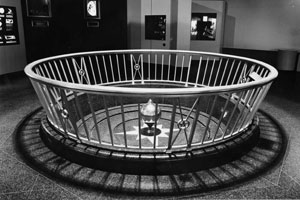 Photo credit: California Academy of Sciences LibraryThere has been a lot of buzz about the innovation of the California Academy of Sciences building as of late. Yet as the opening date draws near it is the nostalgic and historical aspects of the Academy that hold my attention. There are three iconic exhibits of the Academy that have been revived - the Alligator Swamp Tank, African Hall and the Foucault Pendulum. Each exhibit has its own special history and anecdotes but I quite like the science and Academy history of the Foucault Pendulum.
Photo credit: California Academy of Sciences LibraryThere has been a lot of buzz about the innovation of the California Academy of Sciences building as of late. Yet as the opening date draws near it is the nostalgic and historical aspects of the Academy that hold my attention. There are three iconic exhibits of the Academy that have been revived - the Alligator Swamp Tank, African Hall and the Foucault Pendulum. Each exhibit has its own special history and anecdotes but I quite like the science and Academy history of the Foucault Pendulum.
The Foucault Pendulum first demonstrated in February 1851 that the Earth rotates by turning on its axis when French Philosopher Leon Foucault unveiled it in the Meridian Room of the Paris Observatory. His most famous pendulum was exhibited beneath the 279-foot dome of the Pantheon in Paris, hanging from a 219-foot wire. A replica of this famous pendulum swings in the East Pavilion of the Academy, though from only a 30 foot cable. A weight known as a "bob" on the end of a wire swings in a straight arc in relation to the laws of inertia and gravity. Below the constant back and forth arc of the bob a circle of pins set 6 degrees apart rotates. As the Earth rotates the pins come into contact with the constant arc of the bob and are knocked over.
At the Academy located in San Francisco (latitude 37.7°N), the pins will be knocked down every 39 to 40 minutes over a 24 hour period. In twenty-four hours, the pendulum will only knock over 220 degrees worth of pins. Knocking over 360 degrees worth of pins in San Francisco would take 39 hours, where at the North Pole (90° N) it would only take 24 hours.
Why is there a difference? This is because at the North & South Poles, Earth's rotation is enough to explain the change in the pendulum's apparent direction of swing. But as soon as you leave the poles and change latitude, something called the Coriolis Effect comes into play. The Coriolis Effect is an apparent deflection of moving objects when they are viewed from a rotating frame of reference, and its strength varies with latitude. Freely moving objects on the surface of the Earth experience a Coriolis force, and appear to veer to the right in the northern hemisphere, and to the left in the southern. Over time, this continual veering-off-course causes the swing of the pendulum bob to gradually precess, or rotate. This precessing is tracked as the pendulum knocks down pegs set up in a circle beneath it. The farther a pendulum is located from the pole, it will take gradually longer and longer for the pendulum's swing to precess a complete 360°. At the equator, the Coriolis effect is so weak that the pendulum is unaffected - the swing would never precess and therefore the pendulum would never knock over any pegs.
Intestingly, the Coriolis Effect also explains the spiral shapes of hurricanes, cyclonic weather systems, and oceanic gyres and which way they spiral in the northern or southern hemispheres, so the physics works for various natural phenomena, not just for pendulums.
